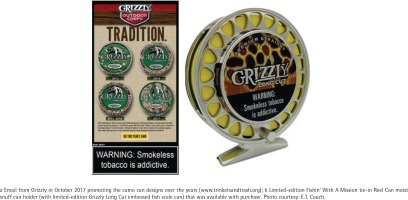Dear Editor,
Moist snuff, the top-selling smokeless tobacco (ST) product in the US, is particularly popular among young males participating in outdoor sports, such as rodeo and baseball1,2. Tobacco manufacturers have a long history of promoting their products with sports imagery and narratives related to individualism and alpha masculinity3. Under recent marketing efforts to target male outdoor enthusiasts, the two largest ST manufacturers, U.S. Smokeless Tobacco Company (parent: Altria Group, Inc.) and American Snuff Company (parent: Reynolds American Inc.), have released limited-edition camouflage (‘camo cans’) and fishing-themed packaging for their most popular moist snuff brands, ‘Copenhagen’ and ‘Grizzly’, respectively.
The U.S. Smokeless Tobacco Company first released ‘camo cans’ in 2009 to promote the launch of Copenhagen Long Cut Wintergreen moist snuff. In 2013, the American Snuff Company followed suit. Each year in the Fall, new limited-edition camo cans are released to coincide with deer hunting season (Figure 1a). Direct mailer and email announcements encourage consumers to visit product websites to redeem coupons, obtain promotional items, and play online ‘hunting’ games. Messages include dollar-off coupons with the text: ‘Hope you are wearing camo. Cause here comes a buck’.
The limited-edition packaging reinforces ST users as rugged sportsmen, reminiscent of decades-long tobacco marketing strategies featuring athlete endorsements2,4 and sporting event sponsorships2, now prohibited in the US. Under increased marketing restrictions, product packaging has gained importance in attracting users and maintaining market share5,6. For cigarettes, adult consumers rate limited-edition packaging as the most attractive and attention-grabbing7. Among adolescent males, seasonal ST promotions have been shown to stimulate interest and create urgency to purchase8, potentially adding perceived value to the product through rarity and exclusivity9.
Limited-edition packaging can link brands to specific identities and values. In Summer 2018, the American Snuff Company released a series of limited-edition fishing-themed cans to promote Grizzly’s ‘Fishin’ With a Mission’ corporate social responsibility (CSR) campaign that claimed a commitment to sportfish and habitat conservation. Campaign promotions also included a website link to enter to win prizes, redeem coupons, or find collectables, such as the Reel Can, a plastic novelty item used for prominent display of a moist snuff can (Figure 1b).
Tobacco manufacturers use CSR and philanthropy to improve their image and influence public health policy10,11, including environmental campaigns focused on planting trees, recycling cigarette butts, and manufacturing ‘earth friendly’ tobacco11,12. However, the same companies that produce and market ST are also the top manufacturers of cigarettes. While the environmental impact of ST is less studied, the harm to wildlife and habitats caused by cigarettes is real13-15.
Limited-edition ST packaging is used to communicate masculine stereotypes, introduce games and novelty items, promote CSR campaigns, and reinforce the relationship between ST and sport. Limited-edition packaging plausibly contributes to misconceptions about the environmental impact of tobacco production and increases youth appeal. Restrictions on advertising and promotion through online and direct mail may reduce the appeal and urgency to purchase limited-edition ST products. Moreover, mandatory plain packaging for all products, including ST, would eliminate the use of limited-edition packaging to communicate with the public, thereby reducing tobacco use in the US.
CONFLICTS OF INTEREST
The authors have completed and submitted an ICMJE form for disclosure of potential conflicts of interest and they declare that they have no competing interests, financial or otherwise, related to the current work. All the authors report grants from US National Institutes of Health National Heart Lung and Blood Institute and Food and Drug Administration Center for Tobacco Products, during the conduct of the study.


